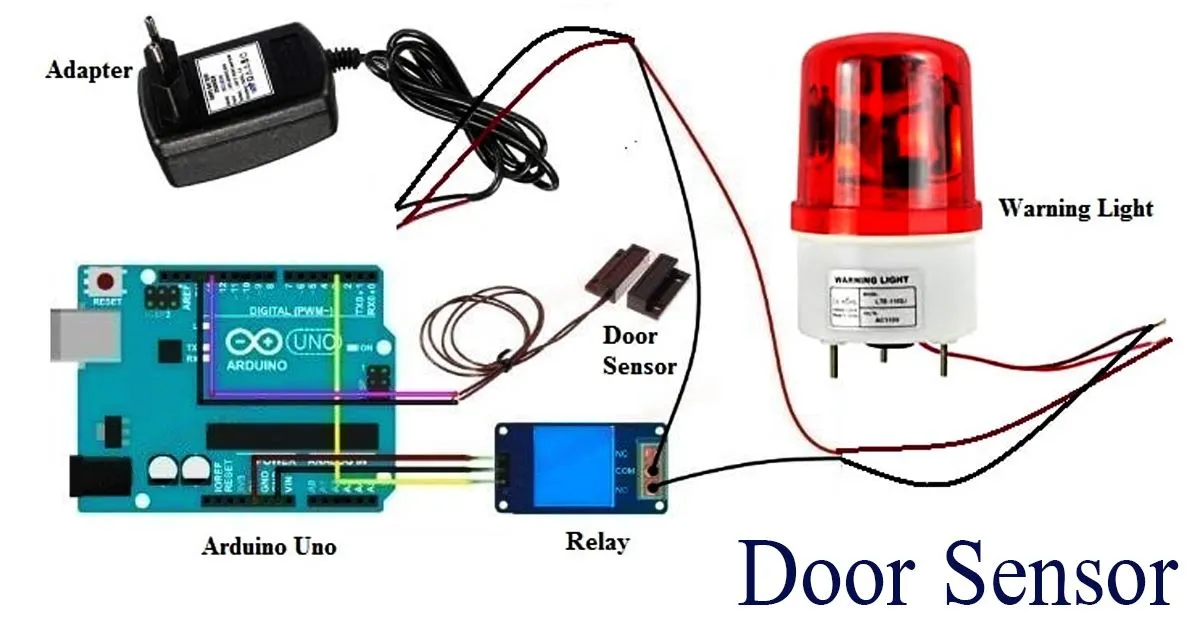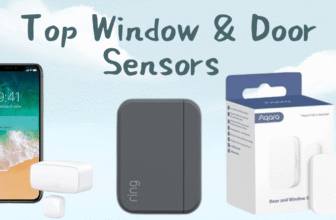
How Does a Door Sensor Work?
A door sensor is an electronic device that detects the opening and closing of doors. It is commonly used in security systems to detect unauthorized entry into buildings or rooms. Now we learn all about what is door sensor and how it work and many more about it.
There are several types of door sensors available. But the most common ones use a magnetic reed switch. This switch consists of two small magnets. one in the door and the other in the frame. When the door is closed, the magnets are aligned, and the switch is closed, indicating that the door is secure.
More about Door Sensor
When the door is opened, the magnets move apart, and the switch opens. It triggers an alarm or notifies the security system. The sensor is connected to a control panel or a smart home hub. Which receives the signal from the sensor and takes appropriate action, such as sounding an alarm. It sends a notification to the homeowner’s smartphone or activates security cameras.
Some door sensors also have additional features such as tamper detection. Which alerts the homeowner if the sensor is removed or tampered with. Others can detect the level of force used to open the door. It provides more information about the type of intrusion.
Overall, door sensors are an essential component of modern security systems. It provides an extra layer of protection and peace of mind for homeowners and businesses alike.
The Advantages of Door Sensors
Door sensors provide a range of advantages for homeowners. It includes protection against unauthorized access. Also, preventing people inside the house from getting out unnoticed, and overall security. They are an essential component of any home security system. As they monitor all entry points to your home. It can detect any unusual activity, alerting you immediately. With door sensors in place, you can have peace of mind knowing. That your home is protected and secure, whether at home or away.
Protect you from outsiders getting in
Door sensors are an essential component of any home security system. It designed to detect when an unauthorized person tries to enter your home. They trigger an alarm or alert the security company. Which can then take action to prevent the intruder from gaining access to your property.
Protect people in your house from getting out
Door sensors also offer an additional layer of protection for people inside the house. Especially young children or elderly family members with dementia or Alzheimer’s disease. If they accidentally leave the house, the door sensor will detect their movement. And it alert you to their whereabouts, ensuring their safety.
Overall Security
Door sensors provide an overall sense of security to homeowners. It monitor all entry points to your home. It can detect any unusual activity, such as opening a door. When no one is expected to be home and alert you immediately. With door sensors in place, you can rest assured that your home is protected and secure.
Types of door sensors
Door sensors are used to detect the opening and closing of doors. And there are an important component of many security systems. There are several types of sensors and detectors, each with its own unique features and applications.
Surface mount
These sensors are typically the easiest to install. It can be simply attached to the surface of the door and frame with screws or adhesive tape. They consist of a magnet and a switch that detects when the door is opened or closed. Surface-mount sensors are commonly used in residential and commercial applications.

Surface Mount Wired NC Door Sensor
Pull-apart sensors
These sensors consist of two parts, one of which is installed on the door and the other on the frame. When the door is opened, the parts separate, triggering the sensor. Pull-apart sensors are often used in high-security applications. Where it is important to detect when someone is attempting to force a door open.
Traditional door sensor
This is the simplest type of door sensor and consists of a switch that is triggered when the door is opened. Traditional door sensors are affordable and easy to install. but it may not be suitable for all applications as they may not be as reliable as other types of sensors.
Recessed door sensor
These sensors are installed inside the door and frame, making them less visible. They are often used in high-end residential and commercial applications where aesthetics are important.
Outdoor door sensor
These sensors are designed to withstand harsh weather conditions and are often used for perimeter security. They typically have a larger range than indoor sensors and are designed to detect movement in a specific area.
Garage tilt sensor
This type of sensor is specifically designed for garage doors and detects. When the door is opened or closed by measuring the tilt of the door.
Door motion sensor
This motion detector alarm and sensor uses infrared technology to detect movement in front of the door. They can be used for security or automation purposes. Such as turning on lights when someone approaches the door.
Magnetic door alarm sensor
This sensor uses a magnet to detect when the door is opened. One part of the sensor is installed on the door and the other on the frame. When the door is opened, the magnet is pulled away from the switch, triggering the alarm.
Wireless door alarm sensor
These sensors are battery-powered and use wireless technology to communicate with the security system. They are easy to install and can be used in a variety of applications. Such as on doors that are difficult to run wires to. However, they may be less reliable than wired sensors as they are dependent on battery life and wireless signal strength. you may find great wireless door sensor alarm
Installing door sensors
Choose the right type of door sensor
There are many different types of door sensors, including wired sensors, wireless sensors, and magnetic sensors. Choose the one that is best for your needs based on the type of door, the location of the sensor, and any other relevant factors.
Prepare the door and door frame
Before installing the sensor, make sure that the door and door frame are clean and free of any debris. If necessary, use a screwdriver or other tool to remove any screws or hardware that might be in the way.
Install the sensor on the door frame
Attach the sensor to the door frame using screws or adhesive. Make sure that the sensor is level and secure.
Install the magnet on the door
Attach the magnet to the door using screws or adhesive. Make sure that the magnet is level and lines up with the sensor when the door is closed.
Test the sensor
Once the sensor and magnet are installed, test the system to make sure it is working properly. Open and close the door several times. It make sure that the sensor is detecting the magnet and triggering the appropriate response.
Connect the sensor to your security system (if applicable)
If you are using the door sensor as part of a larger security system. Connect it to the system according to the manufacturer’s instructions.
Overall, installing door sensors can be a relatively straightforward process that can greatly enhance the security of your home or business. By following these steps, you can ensure that your door sensors are installed correctly and functioning properly.
Where to Place Door Sensors
Door sensors are an important part of any home security system, as they provide an extra layer of protection against intruders. These sensors are designed to detect when a door is opened and send an alert to the security system or monitoring company. But, where should you place these sensors to ensure maximum effectiveness? Here are some tips on where to place door sensors:
Main Entry Doors
The first and most obvious place to put door sensors is on your home’s main entry doors. These are the doors that people most commonly use to enter and exit your home. such as your front door, back door, and garage door. Place sensors on both the door and the door frame to ensure that any movement of the door is detected.
Secondary Entry Doors
In addition to the main entry doors, you should also consider placing sensors on any secondary entry doors, such as those leading to a basement or patio. These doors may be less frequently used than the main entry doors, but they can still provide an entry point for intruders.
Windows
While not technically a door, windows are still a common entry point for burglars. You can place door sensors on windows that are easily accessible. Such as those on the ground floor or those that can be easily reached from a balcony or roof.

Windows door sensor
Interior Doors
Door sensors can also be placed on interior doors, such as those leading to a bedroom or a closet. This can be particularly useful if you have valuable items stored in these areas.
Pet Doors
If you have a pet door, it’s important to place a door sensor on it as well. This will prevent intruders from using the pet door as an entry point.
Sliding Glass Doors
Sliding glass doors are another common entry point for intruders. You can place a door sensor on the door itself or on the frame to detect any movement.
French Doors
If you have French doors leading to your backyard or patio, it’s important to place door sensors on both doors to ensure that any movement is detected.
Overall, it’s important to think about all the potential entry points into your home and place door sensors accordingly. By doing so, you can ensure that your home is well-protected against intruders.
Door sensor use and maintenance
Door sensor use and maintenance: A door sensor is a vital security component that helps detect when doors are opened or closed. To ensure proper functioning, regular maintenance is necessary. This includes checking the batteries, inspecting the switch for wear and tear, and monitoring for weather effects such as extreme temperatures or humidity levels.
Checking batteries: The longevity of your door sensor depends on its battery life. It is essential to regularly check the batteries and replace them when necessary. Most sensors come with an indicator that signals low battery levels, but it is still advisable to conduct routine checks.
Checking for switch wear: The door sensor switch is the component that signals the door’s open or close state. It is susceptible to wear and tear, especially if it is located in high-traffic areas. Regular inspection of the switch can help identify any issues early and prevent sensor malfunction.
Checking for weather effects: Extreme weather conditions can negatively affect your door sensor’s performance. High humidity or temperature can cause the sensor to malfunction, leading to false alarms or failure to detect door movements. Regular inspection and maintenance can help mitigate the impact of weather on your sensor.
How to Choose the Right Door Sensor: When selecting a door sensor, several factors must be considered, such as the type of door, the sensor’s detection range, and compatibility with other security systems. It is essential to choose a high-quality sensor that suits your needs and provides reliable security for your premises
How to Choose the Right Door Sensor
If you want to ensure the security system of your home or office, installing a door sensor can be a wise decision. However, with so many options available in the market. choosing the right door sensor can be overwhelming. Here are a few key factors to consider when selecting the right door sensor:
Price: Door sensors are available at various price points. Choose a sensor that fits within your budget while still meeting your requirements.
Installation: Consider the ease of installation of the sensor. Some sensors require professional installation, while others can be easily installed by the user.
Mobile alerts: Look for a door sensor that can send mobile alerts to your smartphone when it detects any activity. This feature can help you stay informed about any potential security breaches.
Accuracy: Ensure that the sensor provides accurate readings and does not generate false alarms. You don’t want to be alerted every time a breeze blows through the window.
What’s the difference between a door sensor and a window sensor?
Door and window sensors are commonly used in home security systems to detect unauthorized entry. Both types of sensors are designed to detect when a door or window is opened or closed, but there are some differences between them.
A door sensor is a device that is installed on a door and is used to detect when the door is opened or closed. It usually consists of two parts: a magnet and a sensor. The magnet is installed on the door frame. while the sensor is installed on the door itself. When the door is closed, the magnet and sensor are in close proximity. which completes the circuit and signals that the door is secure. When the door is opened, the magnet and sensor move apart. which breaks the circuit and triggers the alarm.
A window sensor
on the other hand. Works in a similar way but is designed for use on windows instead of doors. It also consists of two parts: a magnet and a sensor. The magnet is installed on the window frame. While the sensor is installed on the window itself. When the window is closed, the magnet and sensor are in close proximity. Which completes the circuit and signals that the window is secure. When the window is opened, the magnet and sensor move apart. Which breaks the circuit and triggers the alarm.
Main Difference Between Door Sensors And Window Sensors
One key difference between door sensors and window sensors is the type of contact used to detect whether the door or window is open or closed. Door sensors typically use a magnetic reed switch. Which is triggered by the magnetic field generated by the magnet when it is in close proximity. Window sensors, on the other hand, may use a variety of contact. Types such as magnetic reed switches, tilt switches, or vibration sensors, depending on the design of the sensor and the type of window it is intended to be used with.
In summary, door, and window sensors both serve the same purpose of detecting when a door or window is opened or closed, but they are designed to work with different types of openings and use different methods of contact detection.
Conclusion
In conclusion, door sensors are an essential part of home security systems. Providing a first line of defense against intruders. They work by detecting changes in the magnetic field. When a door is opened or closed, triggering an alarm or notification to the homeowner. There are different types of door sensors available, including surface-mount, pull-apart, traditional, recessed, outdoor, garage tilt, door motion, magnetic, and wireless door alarm sensors. The advantages of using door sensors are numerous.
Including protection against outsiders getting in. Protecting people in the house from getting out, and overall security. It’s important to install door sensors correctly and maintain them regularly. Checking for switch wear, weather effects, and battery life. When choosing the right door sensor, factors to consider include price, installation, mobile alerts, and accuracy. By understanding the differences between door sensors and window sensors. Homeowners can make informed decisions about their home security needs. Overall, incorporating door sensors into a home security system. It can provide peace of mind and enhance the safety of your home and family.






